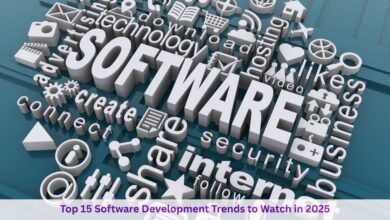
Over the years, software development has undergone continuous transformation, and 2025 is set to be no different. As technology continues to evolve rapidly, businesses and developers must stay updated with the latest trends shaping the industry. The competition is fierce, and innovation is key — from emerging AI tools to groundbreaking frameworks and platforms.
Whether you’re planning to develop a modern mobile app or an advanced web solution, keeping up with these trends will ensure you remain competitive in the ever-evolving software landscape. Let’s explore the key software development trends to look out for in 2025.
1. Low-Code Development Continues to Rise
Building software traditionally requires significant time and technical resources. However, low-code development is transforming that landscape by enabling faster and more cost-effective application creation.
What is Low-Code Development?
Low-code platforms provide visual interfaces with drag-and-drop components, allowing users to design applications with minimal coding. These tools function like specialized Integrated Development Environments (IDEs), tailored to solve specific business problems.
Use Cases of Low-Code Platforms:
- Replacing spreadsheets with cloud-based databases
- Customizing SaaS platforms with business-specific features
- Modernizing legacy systems for better performance
- Building full-stack applications faster using visual workflows and reusable components
Low-code adoption is accelerating, with analysts predicting that over 50% of companies will be using it by the end of the decade.
2. Internet of Behavior (IoB) for Personalization
Expanding upon the Internet of Things (IoT), the Internet of Behavior (IoB) focuses on analyzing user behavior through device interactions.
By 2024, it’s estimated that nearly 40% of the global population had their behaviors tracked in some way. In 2025, IoB is expected to play a critical role in personalization, allowing businesses to customize products, ads, and digital experiences based on behavioral insights — much like how platforms such as Facebook and YouTube tailor content to users.
3. Blockchain Technology: Beyond Cryptocurrency
Once known mainly for its role in cryptocurrency, blockchain is now influencing a broad range of industries due to its decentralized, transparent, and secure structure.
In 2025, blockchain will continue to grow across industries like:
- Supply chain management
- Healthcare systems
- Media rights and royalties
- Secure identity verification
Developers are increasingly exploring blockchain as a foundation for building reliable, tamper-proof software solutions. Market analysts estimate the blockchain sector will reach a valuation of $20 billion by the end of 2024, growing at a CAGR of 58.9%.
4. AR & VR Technologies Gaining Mainstream Traction
Augmented Reality (AR) and Virtual Reality (VR) are no longer confined to gaming. These technologies are rapidly finding applications across industries — from retail and education to healthcare and enterprise training.
The global AR/VR market is expected to exceed $72 billion, driven by:
- More powerful and affordable smartphones and headsets
- Increased enterprise adoption for virtual product showcases and immersive learning
- Innovative app development across industries such as medicine, real estate, and fashion
Expect continued innovation in how these technologies are used to create meaningful digital experiences.
5. No-Code Platforms Accelerating Rapid Development
Similar to low-code tools, no-code development platforms allow even non-developers to build functional apps without writing a single line of code. This trend empowers businesses to prototype, test, and launch products faster and more affordably.
Key Drivers of No-Code Growth:
- A growing number of tech-savvy business professionals (citizen developers)
- The need for fast-paced digital transformation
- Increasing demand for customized internal tools and customer-facing solutions
Popular platforms like Appian, Mendix, and Visual LANSA are being used for automating workflows, transitioning from spreadsheets to databases, and modernizing outdated applications.
6. Cloud Computing Remains a Cornerstone
Cloud technologies are essential for scalable, flexible, and cost-efficient application development. In 2025, the reliance on Software as a Service (SaaS), Infrastructure as a Service (IaaS), and Platform as a Service (PaaS) will grow significantly.
More businesses are investing in cloud-native development to support:
- Remote work
- Scalable operations
- Seamless integration across distributed teams and systems
7. DevSecOps: Embedding Security in Every Step
As cyberattacks become more complex, businesses are embedding security directly into their development pipelines through DevSecOps — a combination of development, security, and operations.
This approach ensures security isn’t just an afterthought but a core element from the start of the development cycle. DevSecOps leads to:
- Reduced vulnerabilities
- Faster deployment
- Stronger compliance with data protection regulations
8. The Growing Impact of AI in Development
Artificial Intelligence (AI) continues to influence how software is built and used. In 2025, AI will play a major role in everything from automating coding tasks to enhancing user experiences.
One key area of focus is Natural Language Processing (NLP) — enabling machines to understand and generate human language, which helps in creating code, analyzing data, and generating documentation automatically.
Additionally, ethical AI is gaining attention. Developers are being urged to design AI systems that make fair, transparent, and responsible decisions.
9. Internet of Things (IoT) Integration Everywhere
The Internet of Things connects devices to the web, allowing them to communicate, analyze data, and automate processes. By 2025, over 65 billion IoT devices are expected to be in use worldwide.
Key applications include:
- Smart home systems
- Predictive maintenance in manufacturing
- Biometric cybersecurity
- Interactive dashboards and interfaces in healthcare and remote workplaces
As more sectors adopt IoT, developers will need to build applications that are real-time, secure, and scalable.
Final Thoughts
The software development trends of 2025 highlight a clear shift toward faster, smarter, and more integrated digital solutions. As businesses continue embracing digital transformation, these trends will shape the future of application development:
- Low-code and no-code platforms will dominate rapid application development.
- Blockchain and IoT will redefine security and connectivity.
- AI and DevSecOps will lead innovation in automation and protection.
- AR/VR will elevate how users interact with software.
- Cloud-native applications will remain critical to scale and flexibility.
By staying on top of these trends, developers and businesses can create cutting-edge, user-centric, and future-ready digital solutions.




